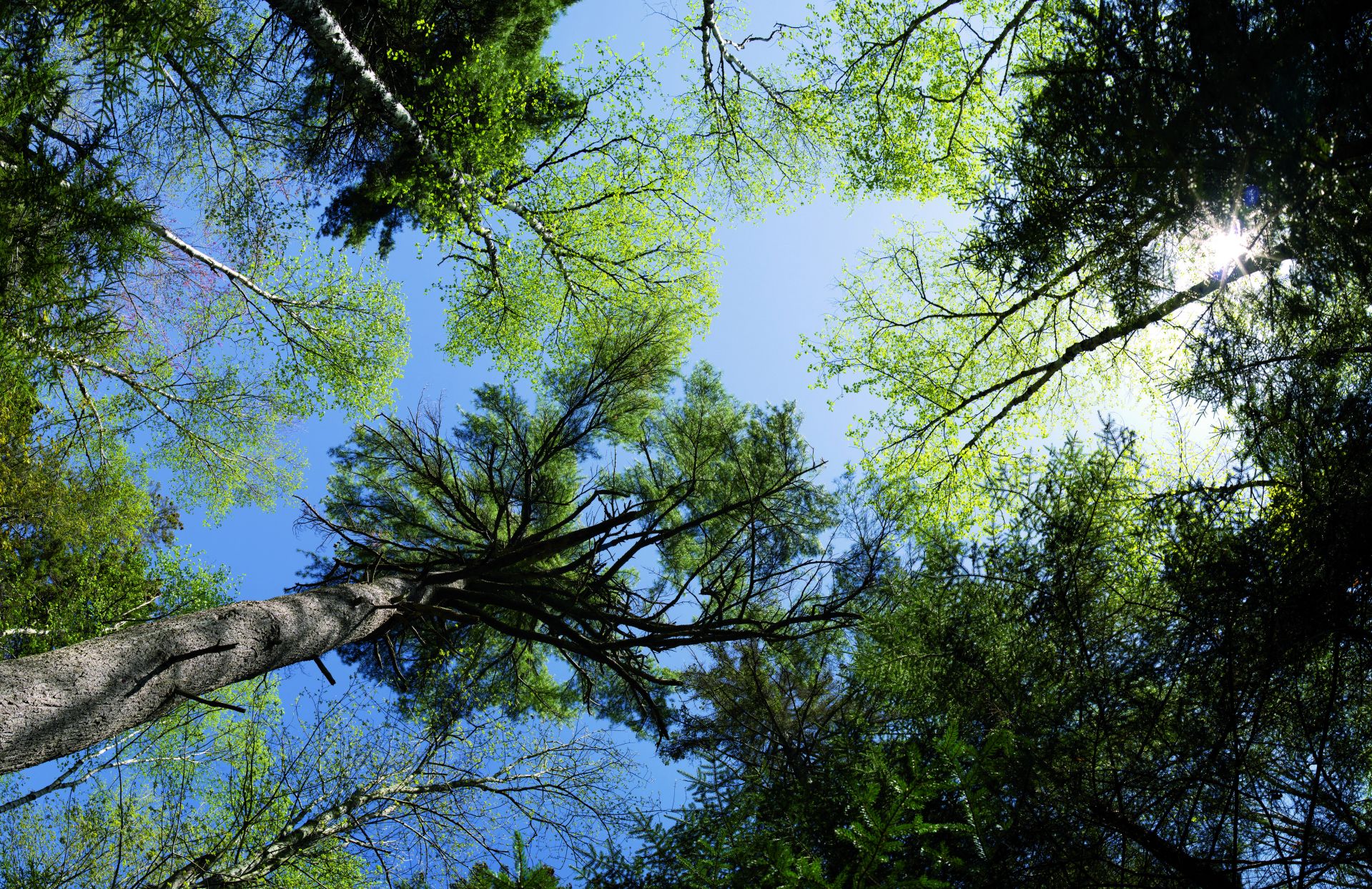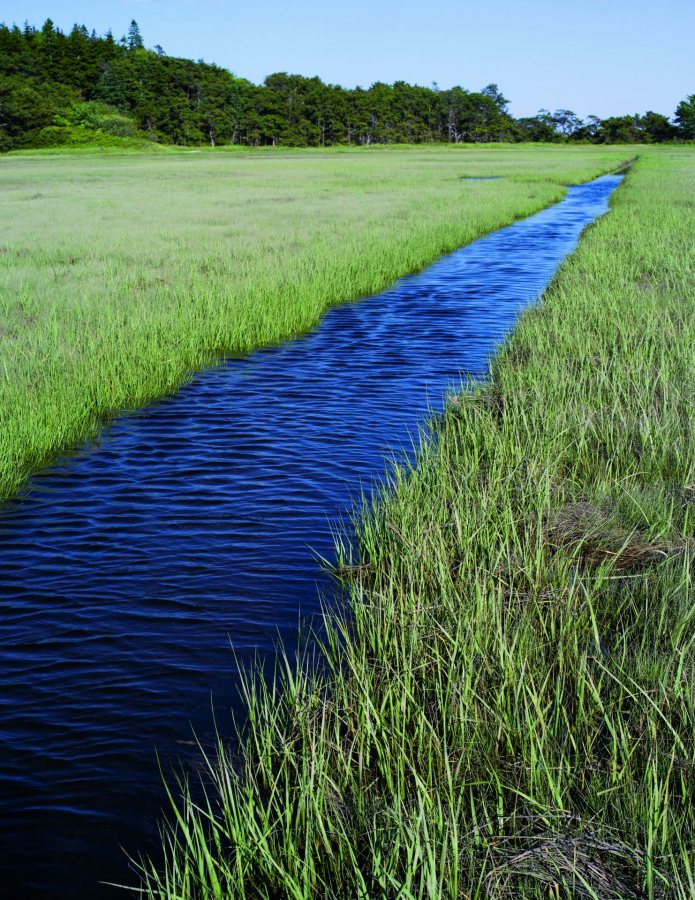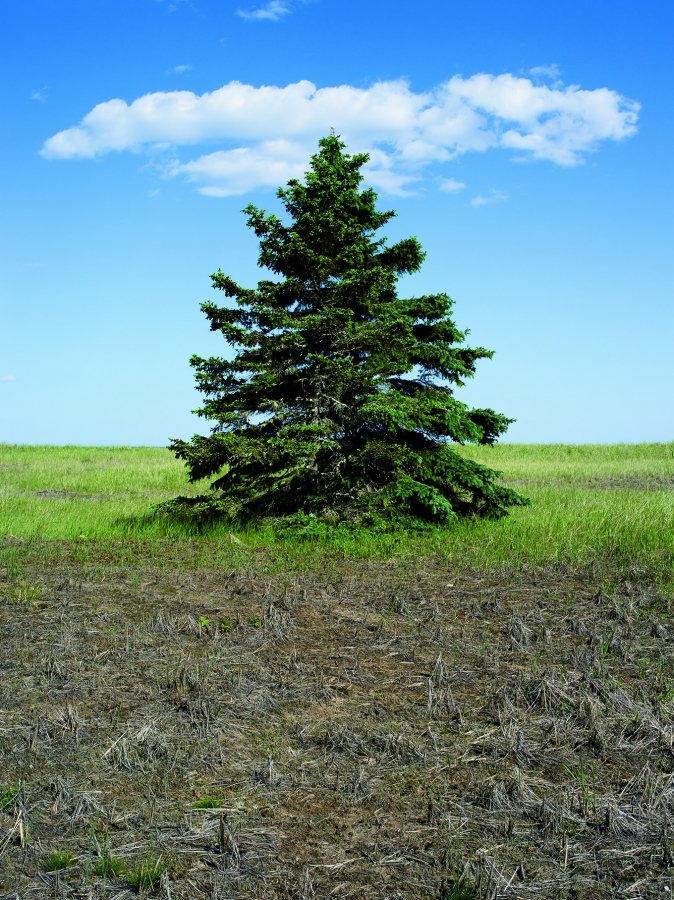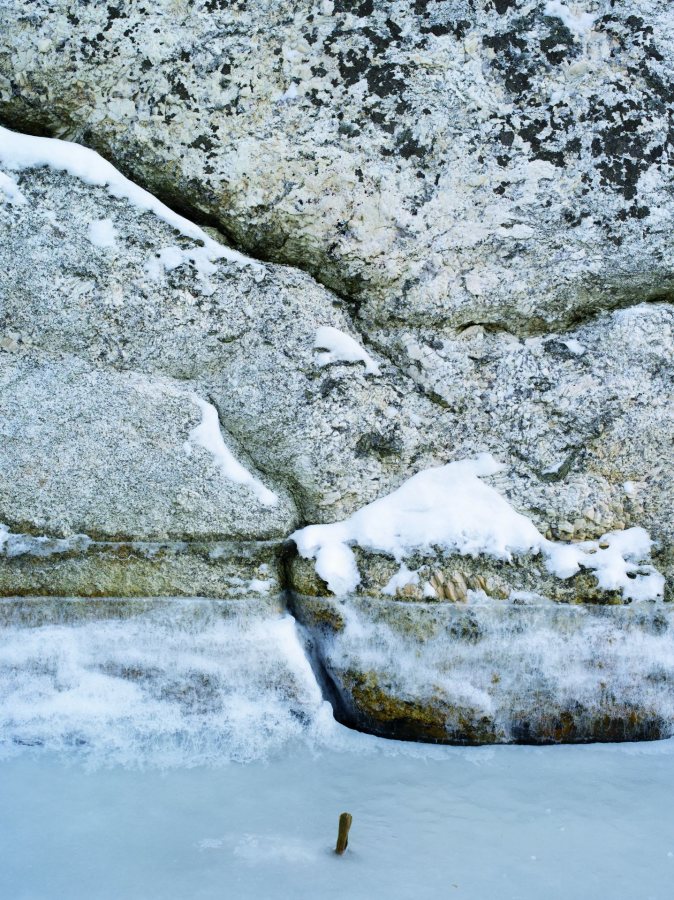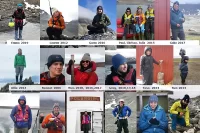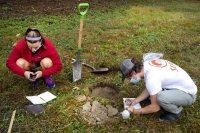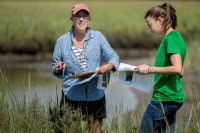
I have been sitting at my desk focused on a two-dimensional screen for several hours, concentrating on the effects of climate change. I glance up to rest my weary eyes.
It is a hot and windless day in late August 2010. To my surprise, I see giant waves hitting the nearby beach and remember that a hurricane was forecast. It must be passing by offshore. The waves, I realize, are loud and relentless. With every crash they send white foam airborne, rising above the largest of the sand dunes.
Just before high tide, I kayak into the marsh I know so well. It is flooded beyond recognition. Meanders and hillocks have disappeared below a mirrored expanse surrounded by upland conifers and filled with the cacophony of terns and gulls seeking shelter from the eccentric storm.
Patches of grass tips appear just above the water’s surface, all of them entirely covered with insects. Huge numbers leap into my kayak as I float by. Spiders, flies, ants and grasshoppers quickly cover my arms and legs, and I realize that they are scrambling to higher ground. The future of coastal insects had never before occurred to me.
I paddle past a dead duck, its black and white feathers splayed open. The thrust of my paddle spins its limp body, and a graceful whirl of contrasting feathers catches my eye and shifts my mind, and I recall that some 80 percent of migrating shorebird populations are in decline. The least terns are entirely gone from here, the piping plovers nearly so.
Paying for Inattention
While the loss of migratory birds and a changing climate may be the most global indications of environmental collapse, the problems are stacked up and ubiquitous. We currently face failing economies, health care systems and ecosystems. Water supplies are dwindling, agricultural lands are contested and lost, and political systems are as fractured as the landscape.
Given the apparently escalating number of environmental disasters and losses, we may understandably bury ourselves in distractions or hide under the covers. Or we get out of bed, brush our teeth and continue with business as usual. Our collective denial is largely due to the difficulty of dedicating attention to such depressing detail. We commonly speak of “paying” attention.
It’s an accurate turn of phrase: Attention is cognitively demanding. Researchers know that there are costs and benefits associated with directing one’s attention, and paying attention to failing systems is painful.
The capacity to direct, intensify and sustain a focus of attention follows a bell-shaped curve, with world champion chess players and athletes at the highly capacitated end of the curve — it has been said that Ted Williams could focus on the stitching of a baseball as it hurled past home plate at 90 miles an hour.
Today’s screen-centric technology has rendered our brains less able to pick up the detail and depth of the natural world.
However, current discourse suggests that we are slipping toward deficiency in our ability to pay attention, and technology may be the reason. Emergent technologies have always captured our attention, and in the process, changed our minds as well. What’s unique, however, is the scale at which today’s screen-centric technology has captured our attention and, according to some, rendered our brains less able to pick up the detail and depth of the natural world.
Experimental philosopher Jesse Prinz defines “attention” as a group of related cognitive functions that allow sensory representations to pass into working memory. Nicholas Carr, author of The Shallows: What the Internet Is Doing to Our Brains, argues that the Internet “is an interruption system. It seizes our attention only to scramble it.” This scrambling of attention refers to a growing inability to sustain one’s focus for any duration, rendering us “shallow,” as little information gets through to working memory.
In fact, experiments show that when our attention jumps from one link or one Web page to the next, our understanding of what has been viewed, browsed or read is significantly minimized. What seems to be lacking is the consolidation of memory as information moves from short-term storage to long-term memory.
Our Internet fixation may also be an example of paying attention to the wrong things. Daniel Kahneman, the Nobel Prize–winning author of Thinking, Fast and Slow, has made two claims regarding our behavior under conditions of uncertainty — perhaps not unlike those caused by our tenuous environmental state. Most famously, Kahneman claims a common lack of rational decision-making. More recently, he claims that we generally focus on “the wrong things.”
Indeed, our common preoccupation with the Internet — Tweeting, Facebooking and online shopping at all hours — suggests that we suffer two-fold: In the context of looming environmental disasters, we focus on the wrong things, and secondly, our ability to sustain a focus of attention has apparently atrophied.
Our minimized and misdirected attention only deepens our denial of true environmental conditions. How can we begin to fathom the fact that, along with shorebirds, 70 to 90 percent of migratory songbirds have disappeared from the northern spring over the last half century? We do not notice the loss. We do not hear what has become silent.
One Word: Plasticity
It has often been said that our environmental crisis is a crisis of perception. We do not readily see the patterns that would reveal our dependence on the natural world, nor are we commonly aware of the systems within which we are deeply embedded. Yet our brains are remarkably adaptive — meaning that neural networks shift continuously as a function of our experience — and by extension, so shifts our perception.
Quite literally, the degree of synaptic strength, or connectedness between neurons, and consequently the way we process sensory information, changes in response to what has captured and held our attention. Over the last three decades, research has demonstrated a surprising degree of “plasticity” in our visual systems in particular.
A second finding claims that sensory system plasticity — the literal restructuring of neural networks in response to experience — depends on the activation of the neural mechanisms responsible for our ability to pay attention.
It is well-known that our capacity to focus and sustain attention is itself readily trained, as exemplified by the long traditions of meditation and mindfulness, and by the practice of visualization. In addition, the 20-year body of research supporting what is called Attention Restoration Theory claims that images of natural scenes serve to restore our cognitive capacity to focus and sustain our attention.
All of this is good news. However, in the large majority of these studies, subjects are exposed to flat photographs of nature, or views through windows. Because the experimental conditions are so significantly bereft of embodied experience, the results, I believe, are greatly understated. How can photographs come close to duplicating the experience of being in nature?
Instead of gazing at a flat image, imagine being awash in sensations. Imagine the plethora of sensations arising simultaneously from warm sunshine and glimmering surfaces, from pungent soils and salty air, and from the quiet whir of chickadees alighting nearby.
Our senses delight in the sensate world. Doing what they evolved to do, they naturally feast on sunsets and clouds streaming by, on the nuances of human expression or the curious behavior of birds. With renewed attention, colors regain vibrancy, patterns pop and what was once barely seen now jumps into view. The world beckons and desires surface as if awakening from slumber.
This is not mere conjecture. It is a tale of subjective experience while doing perception exercises outdoors, for several years, as a visual scientist. Over time, I became convinced that the senses, our bodies and even entire lives can be restored by direct sensory engagement with the still-intact natural world.
But even more significant — because of the collective implications — restoring the power and skill of attention by engaging with the natural world offers us the opportunity to adapt our behavior to changing conditions.
In other words, we gain adaptive value by looking and listening with our attention on full-tilt.
Local Knowledge
I am also a self-proclaimed natural historian of local events. I’ve watched beaches and sand dunes disappear while ragged spines of granite emerge from mountains of sand. Full tides now throw plastic flotsam into upland trees and ice-out on the Kennebec River is many days earlier than in 20th-century Maine. These are observations providing the flesh and bones of climate statistics. They constitute embodied knowledge gained directly through the senses, and in the gut, and they have changed my behavior.
I suggest a forceful shift in one’s focus — consciously looking up and away from that screen — and to the natural world.
Dare I say that this kind of attentive observation is now happening all over the Eastern Seaboard? For example, residents of coastal Norfolk, Va., apparently pay attention to tide tables the way other suburbanites note rush hour traffic. As reported by The New York Times, sea level rise has created chronic flooding, and citizens have lobbied the city council to divert storm drains and raise a small stretch of road by 18 inches, at a cost of $1.25 million.
Fueled by economics, the debate between climate skeptics and believers is much amplified, but one quote in the article makes my point: “No one who has a house here is a skeptic.”
In the words of writer Barry Lopez, attentive observers of the natural world have necessarily become more than “custodian[s] of irrelevant knowledge… but a kind of citizen whose involvement in the political process, in the debates of public life, in the evolution of literature and the arts, has become crucial.”
But sincerely attending to the signs of environmental degradation and change is troubling. Uncertainty arises, often with anxiety riding on its heels. Some suggest that we should avoid “eco-anxiety” at all costs, “lest we succumb to an overwhelming grief — a heartache born of our organism’s instinctive empathy with the living land and its cascading losses,” in the words of environmental philosopher David Abram.
Yet we need not succumb. Again, the power of attention matters most.
Beauty and the Brain
I have argued that we must fully absorb the facts of environmental change through direct observation and serious consideration — no matter the emotional disturbance.
I am also advancing the case of natural beauty as a source of restoration: of our capacity to attend, of our sensory bodies and of our hearts. I suggest that we focus both on environmental change and on natural beauty. This requires shifting our attention, fully.
Beauty, more so than degradation, is everywhere to be seen, reminding us that the world is fundamentally coherent, that things “go together” and function well.
Psychologist and author James Hillman claimed that “beauty is the way in which the gods touch our senses, reach the heart and attract us into life.
Beauty, wrote the poet Robinson Jeffers, is why we “fall in love outwards,” our senses provoked and alert.
Frederick Turner, the author of Beauty: The Value of Values, suggests that the perception of beauty has evolutionary value because it offers us the “capacity to organize meaning in very large quantities of ill-defined information…and to perceive harmonies and regularities that add up to a deep unity.”
My formulation is more pragmatic: Beauty not only seizes our attention, but also links sensations of the aesthetic sort to a reward system buried in the brain. With the repeated firing of particular neurons and networks ensured, a ready appreciation for beauty is easily conditioned. In other words, with beauty before us, our senses are enlivened, attentive and synchronized. Neural substrates are humming and specific synaptic connections become strengthened, thus changing the structure and readiness of neural networks — along with perceptual tendencies and the behavior that follows.
In the case of vision, the result is an aesthetic eye that searches the world for pleasing patterns — for what “goes together.” In this way, the aesthetic response to beauty is a self–organizing principle.
Here, then, is a promising path forward. With attention frequently focused on natural events — on the sun setting, tides spilling, flocks flying north and south, leaves drying, rustling, rotting and composting — our perceptual worlds become more deeply nuanced and vivid, more richly textured, patterned and scented. And, saturated by the generous beauty of the natural order, we “fall in love outward,” perceiving “harmonies and regularities that add up to a deep unity.” We begin to see ecologically, with a relational eye, and to comprehend the depth of our dependence on the natural world. And we begin to care. This changes our behavior.
We begin to see ecologically, with a relational eye, and to comprehend the depth of our dependence on the natural world. And we begin to care. This changes our behavior.
I look up. The wind is dropping now. A broad beam of golden light has just emerged from beneath low clouds, drenching all manner of hill and tree in a golden glow. The sun is quickly disappearing below the horizon, the Earth spinning in silence, and so very fast.
Birds, too, have become silent. Even the grasses are still. It is as if we are holding our breath, all of us as one.
About the Author
Laura Sewall is the director of the Coastal Center at Shortridge and Bates–Morse Mountain Conservation Area, a 600-acre research, education and conservation area on the Maine coast. She earned a doctorate in visual psychology and neuroscience from Brown University, and this essay is adapted from her chapter in Ecopsychology: Science, Totems and the Technological Species (MIT Press, 2012).
‘Between Two Rivers’
The photographs by Will Ash that accompany this essay appear in the photo book Between Two Rivers: A Year at Bates–Morse Mountain Conservation Area.
